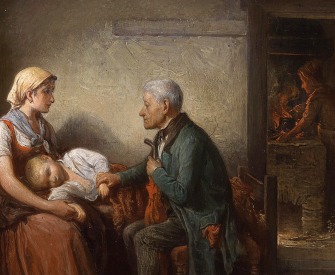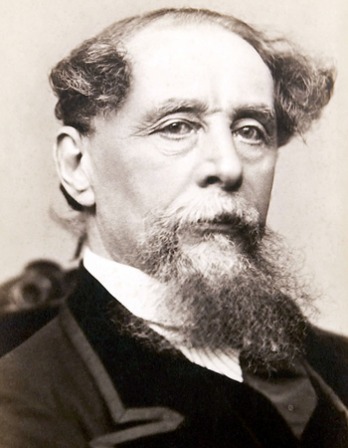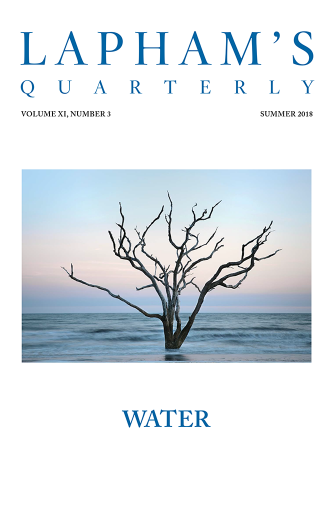I like work; it fascinates me. I can sit and look at it for hours.
—Jerome K. Jerome, 1889The Mother of Possibility
Idleness is what happens when we thwart the impulse to plan forward, and instead enjoy the present.
By Sven Birkerts

Idle Hours, by Julian Alden Weir, 1888. The Metropolitan Museum of Art, Gift of Several Gentlemen, 1888.
Idleness—that beautiful, historically encumbered word. Beautiful because childhood is its first sanctuary and still somehow inheres in its three easy syllables—and who among us doesn’t sway toward the thought of it, often, conjuring what life might be like if it were still a play of appetites and inclinations rather than a roster of the duties and oughts that fill our calendar—indeed, make it necessary that we keep a calendar at all? Encumbered because the word has never not carried the taint of its associations. Idle hands, the idle rich, the downturns that idle workers. Idleness has been branded the obverse of industry, a slap in the face to all healthy ambition. So-and-so is a layabout, a ne’er-do-well, an idler. But for all that, we have not made the word unbeautiful; there is a light at the core, to be remarked, gleaned from the righteous attributions of the anxiously busy.
It is a confusing concept, though, and to find that pure and valid strain, it would help to say what it is not. Idleness is not inertness, for example. Inertness is immobile, inattentive, somehow lacking potential. Neither is idleness quite laziness, for it does not convey disinclination. It is not torpor, or acedia—the so-called Demon of Noontide—nor is it any form of passive resistance, for these require an engagement of the will, and idleness is manifestly not about that. Gandhi was not promulgating idleness, nor was Bartleby the scrivener exhibiting it when he owned that he would “prefer not to.” Nor are we talking about the purged consciousness that Zen would aspire to, or any spiritually influenced condition: idleness is not prayer, meditation, or contemplation, though it may carry tonal shadings of some of these states.
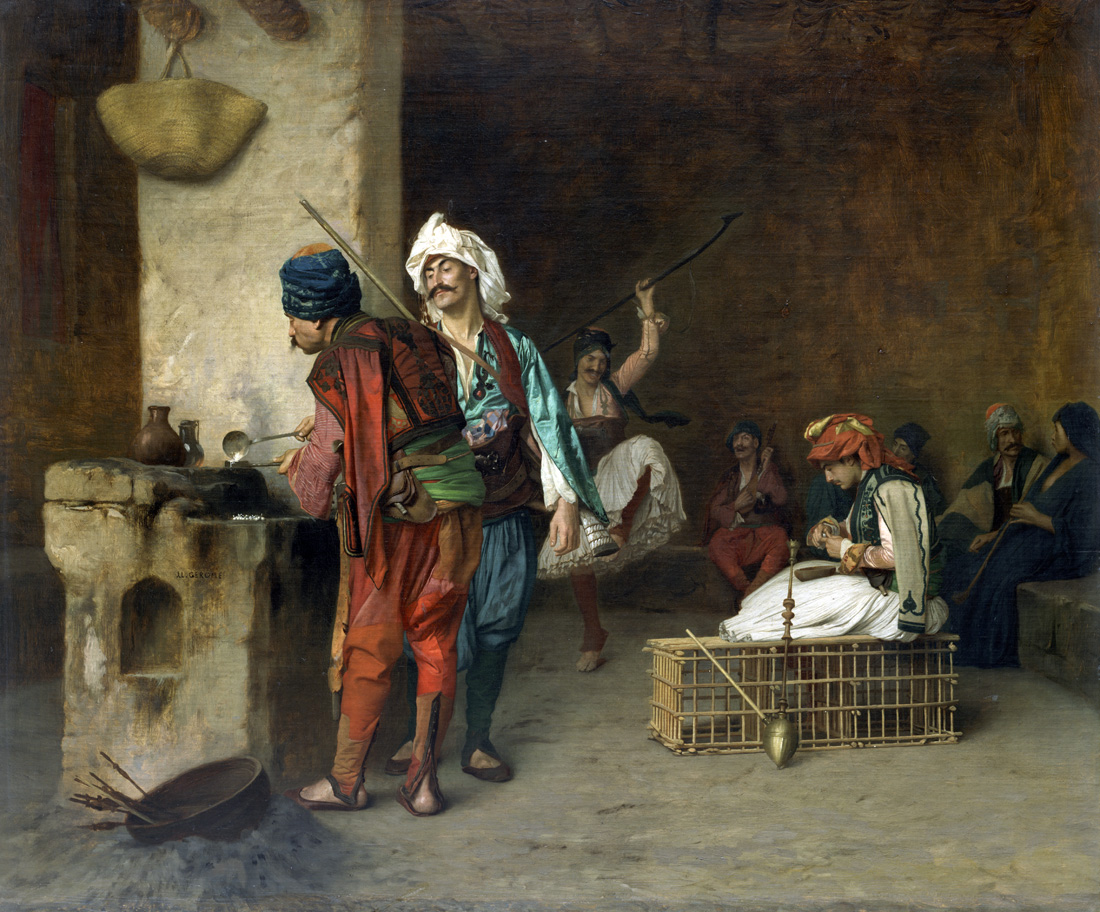
Cafe House, Cairo (Casting Bullets), by Jean-Léon Gérôme, c. 1875. The Metropolitan Museum of Art, Bequest of Henry H. Cook, 1905.
It is the soul’s first habitat, the original self ambushed—cross-sectioned—in its state of nature, before it has been stirred to make a plan, to direct itself toward something. We open our eyes in the morning and for an instant—more if we indulge ourselves—we are completely idle, ourselves. And then we launch toward purpose; and once we get under way, many of us have little truck with that first unmustered self, unless in occasional dreamy asides as we look away from our tasks, let the mind slip from its rails to indulge a reverie or a memory. All such thoughts to the past, to childhood, are a truancy from productivity. But there is an undeniable pull at times, as if to a truth neglected. William Wordsworth’s “Ode: Intimations of Immortality” suggests as much: “But for those first affections,/Those shadowy recollections,/Which, be they what they may,/Are yet the fountain light of all our day,/Are yet a master light of all our seeing.”
Idleness is what supervenes on those too few occasions when we allow our pace to slacken and merge with the rhythms of the natural day, when we manage to thwart the impulse to plan forward to the next thing and instead look—idly, with nascent curiosity—at what is immediately in front of us. It has been with us from the first man and woman—when self was in accord with all nature—and so along with being the core of our childhood sense of the world, it is also the center of our Western legend of creation. Unsurprisingly, it features—the longing, the evocation—through our literature and art from earliest times, changing inflection, intensifying and diminishing depending on historical context. Figuring conspicuously in the pastoral ideal and in the atmospherics of mythologies, the notion has over time taken on dense crosshatchings, in recent centuries at points almost suggesting an epistemology, the basis for a way of true seeing. But it remains a concept-rejecting word. Put too much of any kind of freight on it and its dolce far niente vanishes.
Eden was idleness’ first home, where the well-rested being had nothing to do but open its eyes and behold—until, alas, appetite became ambition and Eden wasn’t. But its echo reverberated throughout the classical tradition, in pastoral, the Idylls of Theocritus in the third century BC (the connection between “idle” and “idyll” is phonetic, not etymological); renditions of rural agricultural life in
Virgil, his Eclogues; in the myth-suffused transformation tales of Ovid. Indeed, it might be said that any literature or art that treats of the pantheon has to do with idleness, for the gods, by definition, in their essence, were uncorrupted by human sorts of striving, and though full of schemes and initiatives, their rhythms were paradisal, eternal, profoundly idle. Walter Benjamin quotes from Friedrich Schlegel’s “An Idyll of Idleness” thus: “Hercules…labored too…But the goal of his career was really always a sublime leisure, and for that reason he became one of the Olympians. Not so this Prometheus, the inventor of education and enlightenment…Because he seduced mankind into working, [he] now has to work himself, whether he wants to or not.”
There is a long-standing connection, a harmony, between literary expressions of idleness and the invocation of the gods, and the lesser rural deities, such as populate the Eclogues. Milton’s “Lycidas” (1637), a pastoral elegy, draws directly on the Virgilian model. The poet’s lament for his deceased friend reimagines a former happy rural leisure—the shepherd in his idleness—complete with “oaten flute” and “rough satyrs” dancing, before the gods see fit to steal it away. We find a similar conflation of the bosky world of the pagan gods and the more leisurely disposition of impulses and affections in Shakespearean comedies, such as A Midsummer Night’s Dream and As You Like It, where customary strivings are overtaken by an almost antic lightness of being.
But myths and rural pastorals are by no means the only expression we find. Michel de Montaigne’s Essays (1580), that cataract of shrewd humane psychologizing—and now the source text for a vast, fertile genre—could be said to have taken its origin in this selfsame condition. Montaigne, who liked to see things not only both ways, but all ways, in his small early essay “Of Idleness,” first deplores it, writing of the mind that, “If it be not occupied with a certain subject that will keep it in check and under restraint…will cast itself aimlessly hither and thither into the vague field of imaginations.” But then, a few sentences later, reflecting on his decision to retire from the endeavors of the world, he reverses, says, “It seemed to me that I could do my mind no greater favor than to allow it, in idleness, to entertain itself.” He goes on to say how, in that freedom, mind “brings forth so many chimeras and fantastic monsters, the one on top of the other…that in order to contemplate at my leisure their strangeness and absurdity, I have begun to set them down in writing, hoping in time to make it ashamed of them.” And so from one man’s idleness is begotten one of the treasures of world literature.
In Montaigne the word clearly equates to imaginative fecundity, though of course we need to remember that for this writer idleness meant a removal from the orthogonal demands of civic life, not any slackening in the exertion of his energies. This needs to be underscored: that idleness does not mark a cessation of the expenditure of energies, only of its more outwardly purposeful application. The rambling, associating shape of the Essays is a testament to this.
A kindred repurposing of energies issued in the momentous surge that was European romanticism. The idealism it espoused, the assumption of a deep and creative bond with nature and the elevation of the uniquely individual over the mechanized and standardized, made it hospitable to the deeper ethos of idleness. Which is to say: to the rhythms and expressions of life unfettered. Witness the poetry in England of Wordsworth, William Blake, Samuel Taylor Coleridge, Percy Bysshe Shelley, and John Keats, or that of Friedrich Hölderlin and Novalis in Germany. Is there a purer, more lyrically nuanced expression of this languor of being than Keats’ “Ode to Autumn,” though here idleness has shifted from a state of possibility to one of almost dazed fulfillment? The poet invokes the season personified:
Who hath not seen thee oft amidst thy store?
Sometimes whoever seeks abroad may find
Thee sitting careless on a granary floor,
Thy hair soft-lifted by the winnowing wind
The gourds are swelling, the bees are buzzing: the note will echo back, many years later, as
W.B. Yeats announces in “The Lake Isle of Innisfree”:
I will arise and go now, and go to Innisfree,
And a small cabin build there, of clay and wattles made;
Nine bean rows will I have there, a hive for the honey bee
And live alone in the bee-loud glade.
The term, it seems, is always in implicit contrast to its opposite—industry—whereas the reverse is not necessarily true. We think of industry, and our thoughts don’t run naturally toward idleness. The basic play of opposites is at work in the writings of the romantics, who were not only for organic individuality, but were also manifestly against—against the “dark satanic mills,” among other things. We pick up a kindred sense of struggle if we look to the United States in the nineteenth century, where the contest of contrary energies was working itself out on a still-great tabula rasa. There is the irrepressible vector of growth, expansion, conquest—industry and trade—and then the counter-thrust, the spiritual and poetic embrace of so much possibility, so much undomesticated terrain. Our unique contrarians had their say. Washington Irving set his Rip Van Winkle dreaming a life away in the mood-drenched Catskill mountains. Walt Whitman, anarchic celebrant, invited his soul to “loaf.” Henry David Thoreau, who remains the most visible spokesperson for doing nothing, provided that it is the right kind of nothing, took to the woods to “front only the essential facts,” an action which had everything to do with awareness and self-attainment and rejected conventionally gainful initiative. Indeed, much of Thoreau’s work can be read as a kind of apologia for attuned idleness. In his well-known essay “Walking,” for instance, he creates a kind of objective correlative in the activity of walking, which he equates to “sauntering,” a word which he explains is “beautifully derived ‘from idle people who roved about the country, in the Middle Ages, and asked charity’…Some, however, would derive the word from sans terre, without land or a home, which, therefore, in the good sense, will mean, having no particular home, but equally at home everywhere. For this is the secret of successful sauntering.” A covert metaphysics lurks, a linking of the unfettered state to more profound outcomes and insights.
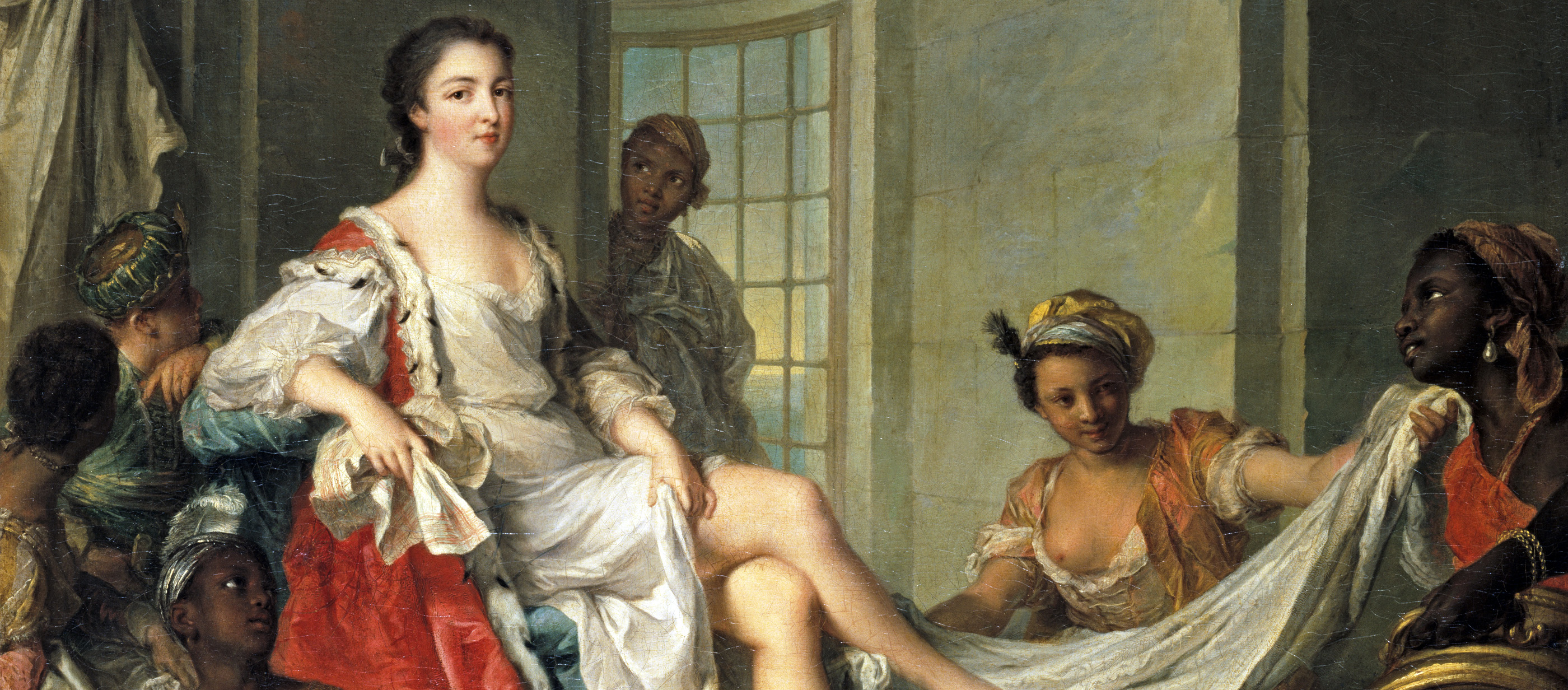
Mademoiselle de Clermont as a Sultana, by Jean-Marc Nattier, 1733. Wallace Collection, London.
Emerson—indeed, the whole Transcendentalist movement, fixed as it is on interiority—is in essential accord, though in his journals of 1840 we find him playing a puckish reverse of Montaigne’s assertion, writing, “I have been writing with some pains essays on various matters as a sort of apology to my country for my apparent idleness.” But there is a wink in the sentence, a droll delineation of outer from inner in that word “apparent.”
These nineteenth-century American thinkers and writers, by and large opposed to the commerce-driven expansionist spirit of the day, were not only deeply bound up with a deeper reading of nature, but also gave heed to the spirit we find in the work of the soulful Chinese wandering poets, Li Bai and Du Fu, or the Japanese Buddhist priest
Yoshida Kenkō, whose Essays in Idleness, dating from the early fourteenth century, reflect on the immersed intensity of life lived apart from public agitations: “What a strange, demented feeling it gives me when I realize I have spent whole days before this inkstone, with nothing better to do, jotting down at random whatever nonsensical thoughts have entered my head.” Eastern religions, which have long pledged receptivity over initiative, also found ready adherence in the United States. The same idle posture that right-thinking Protestants everywhere deplored was seen by the Transcendentalists as evidence of a philosophical and spiritual openness.
At more or less the same time, in Europe, a very different expression of this temper, this disposition, was manifesting itself. The madly expanding urban centers, Paris especially, began to spawn their own contrary figures, those who proclaimed a deliberate resistance to progress of the sort represented by Baron Haussmann’s massive architectural program, which was bent on imposing order upon the metropolis. Set against the mentality of progress was the flâneur, who, as characterized and celebrated by Charles Baudelaire, esteemed the useless, the gratuitous, anything that would serve to mock the ends-driven compulsion of the age.
“To be away from home and yet to feel at home anywhere,” he wrote in his essay on artist Constantin Guys, “to see the world, to be at the very center of the world, and yet to be unseen of the world, such are some of the minor pleasures of those independent, intense and impartial spirits, who do not lend themselves easily to linguistic definitions.” The flâneur, the urban saunterer, advertised the value of leisure and enacted the implicit protest of tarrying. Schlegel might have had such a figure in mind when he wrote, “And in all parts of the world, it is the right to idleness that distinguishes the superior from the inferior classes.” Time is money, money is time, and the apotheosis of having is doing nothing at all.
It is shameful and inhuman to treat men like chattels to make money by, or to regard them merely as so much muscle or physical power.
—Pope Leo XIII, 1891Through the figure of the flâneur—via the writing of critic and philosopher Walter Benjamin—the idle state was given a platform, elevated from a species of indolence to something more like a cognitive stance, an ethos. Benjamin’s idea is basically that the true picture of things—certainly of urban experience—is perhaps best gathered from diverse, often seemingly tangential, perceptions, and that the dutiful, linear-thinking rationalist is less able to fathom the immensely complex reality around him than the untethered flâneur, who may very well take it by ambush.
A related but psychologically more complex aesthetics of indirection is found in Marcel Proust, who, as author of the monstrous and breathtakingly intricate In Search of Lost Time, cannot himself be tagged as an idler, but who is nonetheless a pantheon figure in any deeper discussion of the topic. For it was Proust, drawing on the philosophy of Henri Bergson, who proposed so-called involuntary memory as the source of all deeper artistic connectedness, as opposed to that which any of us can retrieve upon command. “The past is hidden somewhere outside the realm, beyond the reach of intellect, in some material object…which we do not suspect. And as for that object, it depends on chance whether we come upon it or not before we ourselves must die.” No willing one’s way to the truth. One can only make oneself receptive and hope. Which is to say, and not all that roundaboutly, that the inactive, receptive posture is likely to have a better purchase on what ultimately matters than concerted activity.
Proust also supplies another important link, that between idleness and reading, idleness and creative reverie. Thus far we have tended to think of the word in its obvious opposition to industry, and this as manifesting physical inaction. But of course there are the inward aspects as well. Consider daydreaming, so often deemed purposeless, a kind of mental laying about, even though there is testimony abounding from artists, composers, and authors claiming it as the very seedbed of their inspiration. In the “Combray” section of Lost Time, the narrator gives an extended recounting of his experience of childhood reading. He fuses the ostensibly directional, subject-oriented aspects of the task with the atmospheres of indolence, the sensuous inner dilations that accompany it. Recalling how he would secrete himself in what he calls a “sentry box” in the garden, he asks of his thoughts, “Did not they form a similar sort of hiding hole in the depths of which I felt that I could bury myself and remain invisible even when I was looking at what went on outside?” How familiar is this feeling, this impulse to hide the self away when reading, both because hiding not only intensifies the focus, but keeps the reader out of the sightlines of those who anoint themselves the guardians and legislators of our moral well-being.
For all its openness to profundity and creative insight, maybe precisely because of that, idleness is deemed objectionable. Creative insight is so often an implicit questioning of the rationales of the status quo. Idleness wills nothing, espouses no agenda of progress; it proposes the sufficiency of what is. And our aforementioned guardians find this intolerable, a defiant vote against their idea of what should be. Will is the defining term. Will is the reason why Bartleby the scrivener—a figure who out-Kafkas Kafka, out-Becketts Beckett—cannot be annexed to the idler’s ranks: his immobility is a concerted refusal, the opposite of idleness, which is neither concerted nor refusing. He reminds us that idleness is primarily a form of assent—but assent to the rhythms of the natural world and not its improvers and exploiters. And where do we put the titular figure of Oblomov (1859), Ivan Goncharov’s paragon of immobility, whose inability to get himself off his divan to do anything appears less a matter of defiant will than an paralytic inertia? Is he an idler, or his nation’s first refusenik?
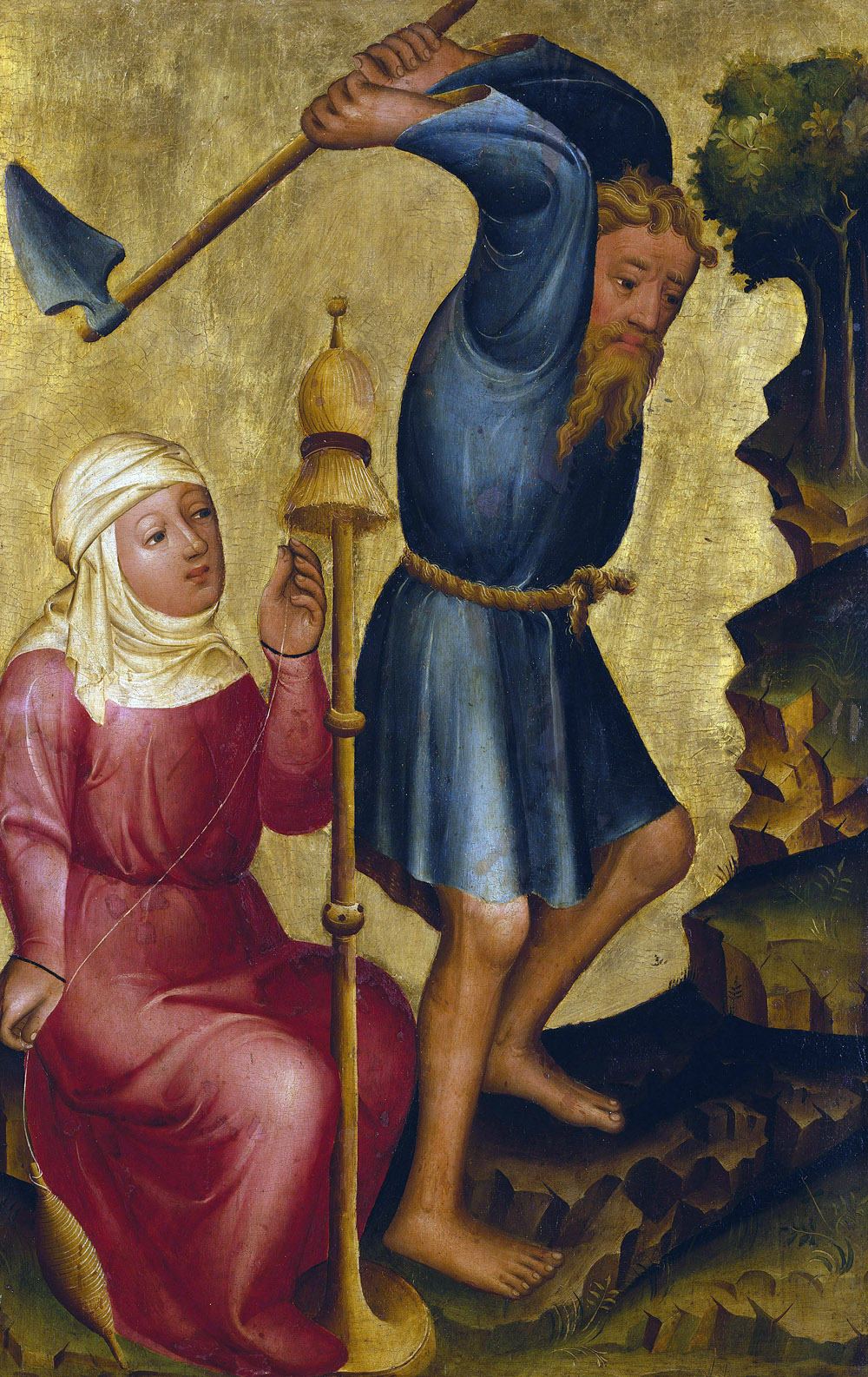
The labors of Adam and Eve, from the Grabow Altarpiece, by Master Bertram of Minden, c. 1381. Kunsthalle Hamburg, Germany.
Again, any pronouncement feels reductive. There are so many ways to look at idleness. We have to differentiate the traveler in the airport lounge who is fiddling with his iPod settings from the Whitmanic dreamer who is loafing and inviting his soul. One end of the spectrum of idleness is almost indistinguishable from boredom, the other may find a person dreaming his way toward yet another proof for Fermat’s Theorem. We can consider idleness as a principle, a lived vocation, if you will, but then also regard it in flashes, which is how so many of us practice it—as a respite from concerted activity, known to be of limited duration and prized all the more for that reason. Who is idle, what is idleness? It’s so much a question of the inner disposition, and where the mind finds itself when the I is obeying no directives at all. There is the further distinction between the subjective and solitary and the collective, public expressions—what one feels alone in an armchair, as opposed to the feeling of being with others in a park on a Sunday or at a lake. Here well-known images of public languor come to mind—Thomas Eakins’ swimmers, George Seurat’s Sunday Afternoon on the Island of La Grand Jatte, Édouard Manet’s Luncheon on the Grass—works all suffused with duration, a sense of life being lived outside the radius of the clock face. Alongside these are vivid verbal depictions, like the nostalgic rendering by E.B. White in “Once More to the Lake,” or the indulgent tableaux of good eating with friends in M.F.K. Fisher or Calvin Trillin, or Albert Camus calling back the summers of his youth in Algiers:
In Algiers, you don’t talk about “going swimming” but about “knocking off for a swim.” I won’t insist. People swim in the harbor and then go rest on the buoys. When you pass a buoy where a pretty girl is sitting, you shout to your friends, “I tell you it’s a seagull.” These are healthy pleasures. They certainly seem ideal to the young men.
People together in a place, their actions loosely defined, not tending toward any larger consummation.
Things are different now. New variables have been thrust into our midst—or, more likely, we have evolved our way into them. The old definitions of activity, the sturdy distinctions between work and leisure, have been broken down by the encompassing currents of digitized living. Obviously industry has not vanished, nor industriousness, but it has widened and blurred its spectrum to include the myriad tasks we accomplish with our fingertips. The spaces and the physical movements of work and play are often nearly identical now, and our commerce with the world, our work life, is far more sedentary and cognitive than ever before. Purposeful doing is now shadowed at every step with the possibilities of distraction. How do we conceive of idleness in this new context? Are we indulging it every time we switch from a work-related document to a quick perusal of emails, or to surf through a few favorite shopping sites? Does distraction eked out in the immediate space of duty count—or is it just a sop thrown to the tyrant stealing most of our good hours?
I wonder how all this clicking and mouse-nudging impinges on our arts, our literature, and if any of the old ease can survive. I was delighted recently to open Geoff Dyer’s Yoga for People Who Can’t Be Bothered to Do It and hear him announcing, “In Rome I lived in the grand manner of writers. I basically did nothing all day.” But Dyer seems an exception to me, a survival from another era. We are few of us in Rome, and fewer up for the “grand manner.” Who still idles? Sieving with the mind’s own Google I pull up a few names: the late W.G. Sebald, Haruki Murakami, Marilynne Robinson in her reverie-paced scenemaking, Nicholson Baker in The Anthologist…But finally there are few exemplars. Most contemporary prose, I find, agitates; it creates a caffeinated vibration that is all about competing stimuli and the many ways that the world overruns us. Idleness needs atmospheres of indolence to survive. It is an endangered condition that asks for a whole different climate of reading, one that is not about information, or self-betterment, or keeping up with the latest book-club flavor, but exists just for itself, idyllic, intransitive.
I recently heard a commencement speech by critic James Wood in which he lamented the loss of pungency from our lives—so much is now sanitized or hidden away from the public eye—and exhorted would-be writers to search deep in their imaginations for the primary details that animate prose and poetry. On a similar track, I wonder about childhood itself. I worry that in our zeal to plan out and fill up our children’s lives with lessons, play dates, CV-building activities we are stripping them of the chance to experience untrammeled idleness. The mind alert but not shunted along a set track, the impulses not pegged to any productivity. The motionless bobber, the hand trailing in the water, the shifting shapes of the clouds overhead. Idleness is the mother of possibility, which is as much as necessity the mother of inventiveness. Now that our technologies so adeptly bridge the old divide between industriousness and relaxation, work and play, either through oscillation or else a kind of merging, everything being merely digits put to different uses, we ought to ask if we aren’t selling off the site of our greatest possible happiness. “In wildness is the preservation of the world,” wrote Thoreau. In idleness, the corollary maxim might run, is the salvaging of the inner life.

